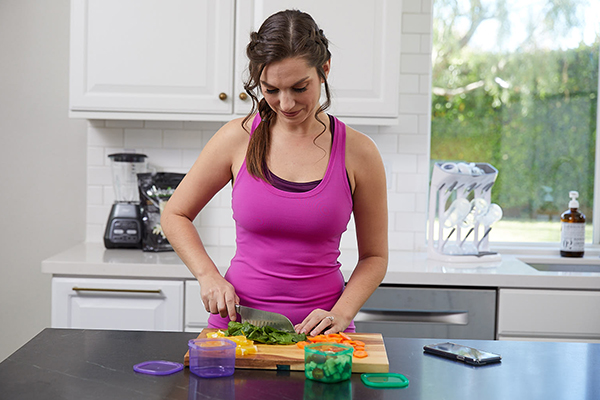How to Start Working Out

If you haven’t exercised or tried to eat clean in a while (or ever), the first day of a 30-, 60-, or 90-day fitness and nutrition program can feel intimidating.
The thought of embarking on a weight-loss journey can seem scary. It doesn’t have to.
First, you can commit to a shorter program, such as Beachbody On Demand‘s Clean Week, a 7-day nutrition and fitness program created to help you take that first step on your fitness journey and establish lasting healthy habits.
Read on for more tips on how to get started with nutrition and fitness.
With these simple suggestions, you can begin to prepare your body and mind for a healthier lifestyle before you even break a sweat or eat your first green vegetable.
How to Start Working Out
If you want to start working out, it’s important to be mentally prepared — before you even break a sweat.
Healthier eating is one key way to set yourself up for success.
Clear your kitchen of unhealthy foods, and follow a nutrition plan that will fuel your workouts and provide the nutrients you need for recovery.
You also need to make sure you’re in the right mindset to stay committed and motivated for the long haul.
Start with these simple steps to set yourself up for success.
1. Figure Out How Many Calories You Should Eat

Knowing is half the battle, right?
Use this simple method to determine approximately how many calories you should try to eat each day, or consult your fitness program’s nutrition guide, and begin to make small adjustments to reach that daily goal.
Once you have your target, keep track of what you’re eating each day.
Many people dramatically underestimate serving sizes or mindlessly graze throughout the day, says Mary Wirtz, R.D., a consultant for Mom Loves Best.
“Use a paper journal or a nutrition app and track your typical nutrition intake to get a better understanding of what you are doing well and what needs to improve,” Wirtz says.
Bonus: Research suggests consistent dietary tracking is linked to more successful and sustained weight loss results.

Save
Save

2. Drink more water
Being dehydrated can make you feel sore even if you don’t exercise.
Set yourself up for success — and minimize initial muscle soreness — by drinking plenty of water in the days leading up to the start of your fitness program.
Get in the habit of drinking enough water every day.
Start by finding out how much water you need and get tips to help you drink enough.
3. Get rid of junk food
Empty your desk, cupboards, fridge, freezer, car, and secret snack stash drawer of junk foods and sugary drinks that don’t support your goals.
If the packaged foods are unopened, donate them. Brainstorm some healthy snacks to reach for instead.
For example, Shakeology can help to curb your sweet cravings and satisfy your hunger in a healthier way.
(Still struggling to part with your snack stash? Try these tips to kick your junk food habit.)
4. Create a healthier pantry
Stock your kitchen with nutrient-dense foods to ensure you always have the ingredients you need to whip up a healthy snack or home-cooked meal.
Here is a list of 17 pantry essentials to get you started.
“Keep things simple,” says Clean Week‘s Super Trainer, Megan Davies. “There’s so much information out there about different diets. Make sure that your new eating plan and meal preps are uncomplicated, and that they’re doable for you. That will help you stay with it.”
5. Find your “why”
“If you’re really caught up in the numbers on the scale, or the dress size, and what’s happening with the tape measure, chances are those things won’t really motivate or inspire you in the long term,” says Beachbody Super Trainer Tony Horton.
“Find a new purpose. Find a new reason ‘why’ you show up every day to work out,” he adds. “The reason ‘why’ has got to be so powerful, so strong that you’re not going to quit, you’re not going to fail, and you’re going to be consistent, and show up five to seven days a week for the rest of your life.”
6. Build a support system
When considering how to start working out again, remember that getting fit doesn’t have to be something you do alone!
Announce your commitment to get healthier and stronger to your friends, family, or coworkers.
Joining a BODgroup is a great way to find a support system of workout buddies and accountability partners to help you stay motivated when your resolve starts to slip or you feel tempted to make unhealthy choices.
7. Make time in your schedule
You wouldn’t skip a meeting with your boss just because you feel tired or grumpy, would you?
No — you’d be there on time with a smile on your face and do your best to impress. So treat each workout like an important meeting with yourself.
Figure out what time of day typically works best for you. Will you work out in the morning? During your lunch break? In the evenings?
Then schedule it in your calendar, commit to it, and make adjustments to reserve that time slot every day.
With Beachbody On Demand, you can take your workouts anywhere and play them at any time. No matter your schedule, you can have your favorite trainer motivating you to reach your goals.
8. Jumpstart your weight loss
Before you start working out, you can get into a healthier mindset and start your weight-loss journey with 3-Day Refresh or Ultimate Reset.
On the 3-Day Refresh, you’ll strengthen your willpower and break the cycle of bad eating habits.
The longer Ultimate Reset is 21 days and eases you into the process of prepping and eating wholesome foods. This can make the transition into eating healthy foods easier.
9. Figure out your triggers
Many people make healthy choices for the most part, but when a certain thing happens or they start to feel overwhelmed, those choices go out the window and somehow a dozen donuts get eaten.
“Identify the triggers in your life that cause you to not take care of yourself like you normally would,” Davies says.
“That way, when those things happen, you can pinpoint them and say to yourself, ‘Okay, here it is…this is going on right now, but I’m not going to spiral out of control this time.'”
“Just identifying it helps you have more control over your life,” Davies explains.
How to Get Started Working Out at Home or at the Gym
Once you’ve taken the first steps towards a healthier lifestyle using the tips above, you can tackle the next question: How should a beginner start working out?
Be sure to ease into any new workout routine and establish a baseline of fitness.
This can help you avoid injury and burnout.
Remember that working out doesn’t have to mean lifting heavy dumbbells or crushing an intense HIIT workout.
You can start with stretching, simple movements, and gentle walks.
Whether you’re working out at home or at the gym, these beginner-friendly movements can help you develop a more active lifestyle.
Here’s how to start building a solid fitness foundation.
1. Stretch
If you haven’t used your muscles in a while, do some gentle stretching to wake them up and get familiar with the current limits of your flexibility.
Knowing where you’re tight can help prevent injury.
Try these stretches to improve hip and lower back flexibility so you’ll be ready to move comfortably in workouts.
You can also try Beachbody’s 3 Week Yoga Retreat, which will guide you through 21 days of beginner yoga classes to improve your flexibility.
2. Start moving
Even if you’re not pushing play yet, you can begin to make an effort to move your body more every day.
“Start with one baby step and then gradually build on it,” says John Gardner, NASM-certified personal trainer and the CEO and co-founder of Kickoff.
For example, commit to a short walk in the morning or a 30-minute stretch routine before bed.
“Once you get into the habit and your brain has allocated a certain time slot to fitness, you can start picking up the intensity, adding more days, or doing more challenges,” Gardner adds.
3. Make space for your workouts
When considering how to get started with fitness, look at your surroundings and make some decisions.
This could be as easy as moving the coffee table in your living room, or as elaborate as setting up the ultimate home gym in your garage or basement.
You won’t need much space to exercise, but it’s a good idea to figure out where you’ll do it and make the space usable and inviting for the workouts you’ll be doing.
4. Plan active outings
A great way to get into the spirit of exercise before you actually commit to a longer fitness program is to plan activities with friends that get you moving.
“Find an outdoor activity you like to do ‘just because,'” suggests Garett Reid, MSc, C.S.C.S., CISSN, head fitness consultant at Set for Set.
Invite friends out for a hike, go ice skating, take a bike ride, or organize a family softball or flag football game.
5. The most important tip: Go at your own pace
You don’t have to go full speed on the first day.
If you’ve been spending the last few months (or years) sitting on the couch, you may either injure yourself or be in so much pain that you can’t walk the next day if you push too hard.
That certainly won’t motivate you to keep going.
You should be exercising at a level that makes you feel good — not a level that causes pain.
If you’re struggling to keep up with a new workout you’ve never tried before, ease in slowly.
On Day 1, just do the first ten minutes.
Then add a few minutes each day until you can do the full workout.
Ten minutes of exercise a day is better than no minutes!
How Long Will It Take to See Results From Working Out?
There’s no one-size-fits-all answer because everyone’s fitness journey will be different. How fast you see results will depend on how consistent you are and the intensity of your workouts.
But keep in mind that working out too hard too often can backfire. Rather than trying to reach your fitness goals as quickly as possible, focus on finding a workout routine you can stick with.
As your fitness level improves, you can continue to challenge yourself with more intense workouts. Above all, go at your own pace.
If you consistently show up and push play, the results will follow.